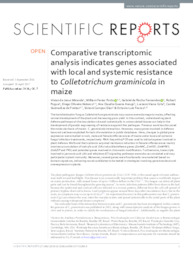Comparative transcriptomic analysis indicates genes associated with local and systemic resistance to Colletotrichum graminicola in maize.
Comparative transcriptomic analysis indicates genes associated with local and systemic resistance to Colletotrichum graminicola in maize.
Author(s): MIRANDA, V. de J.; PORTO, W. F.; FERNANDES, G. da R.; POGUE, R.; NOLASCO, D. O.; ARAUJO, A. C. G.; COTA, L. V.; FREITAS, C. G. de; DIAS, S. C.; FRANCO, O. L.
Summary: The hemibiotrophic fungus Colletotrichum graminicola may cause severe damage to maize, affecting normal development of the plant and decreasing grain yield. In this context, understanding plant defense pathways at the inoculation site and systemically in uninoculated tissues can help in the development of genetic engineering of resistance against this pathogen. Previous work has discussed the molecular basis of maize - C. graminicola interaction. However, many genes involved in defense have not yet been exploited for lack of annotation in public databases. Here, changes in global gene expression were studied in root, male and female inflorescences of maize under local and systemic fungal infection treatments, respectively. RNA-Seq with qPCR was used to indicate genes involved in plant defense. We found that systemic acquired resistance induction in female inflorescences mainly involves accumulation of salicylic acid (SA)-inducible defense genes (ZmNAC, ZmHSF, ZmWRKY, ZmbZIP and PR1) and potential genes involved in chromatin modification. Furthermore, transcripts involved in jasmonic acid (JA) and ethylene (ET) signaling pathways were also accumulated and may participate in plant immunity. Moreover, several genes were functionally re-annotated based on domain signature, indicating novel candidates to be tested in strategies involving gene knockout and overexpression in plants.
Publication year: 2017
Types of publication: Journal article
Unit: Embrapa Maize & Sorghum
Keywords: Antracnose, Colletotrichum Graminicola, Doença de planta, Gene, Maize, Milho, Resistência a doença
Observation
Some of Embrapa's publications are published as ePub files. To read them, use or download one of the following free software options to your computer or mobile device. Android: Google Play Books; IOS: iBooks; Windows and Linux: Calibre.
Access other publications
Access the Agricultural Research Database (BDPA) to consult Embrapa's full library collection and records.
Visit Embrapa Bookstore to purchase books and other publications sold by Embrapa.

